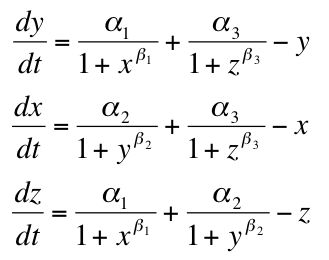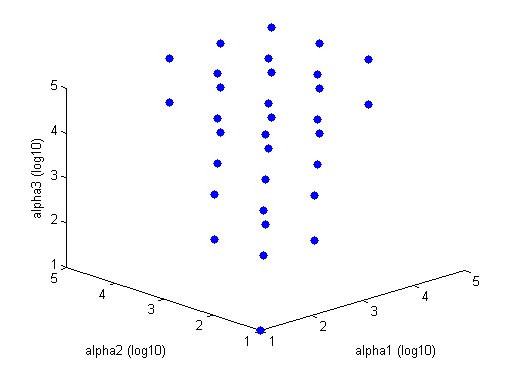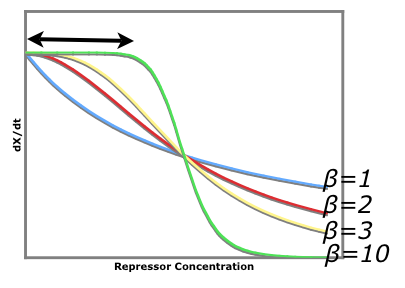Tristable/Modeling
From 2007.igem.org
(→Stability) |
(→The Model) |
||
| (7 intermediate revisions not shown) | |||
| Line 78: | Line 78: | ||
<tr> | <tr> | ||
<td width=99> | <td width=99> | ||
| - | <a href="Brown"><image src="https://static.igem.org/mediawiki/2007/2/20/Home_reg.gif" alt="Home" border=0></a> | + | <a href="../Brown"><image src="https://static.igem.org/mediawiki/2007/2/20/Home_reg.gif" alt="Home" border=0></a> |
</td> | </td> | ||
<td width=99> | <td width=99> | ||
| - | <a href="lead"><image src="https://static.igem.org/mediawiki/2007/2/2a/Lead_reg.gif" alt="Lead Sensor" border=0></a> | + | <a href="../lead"><image src="https://static.igem.org/mediawiki/2007/2/2a/Lead_reg.gif" alt="Lead Sensor" border=0></a> |
</td> | </td> | ||
<td width=99> | <td width=99> | ||
| - | <a href="tristable"><image src="https://static.igem.org/mediawiki/2007/7/79/Tri_pressed.gif" alt="Tristable Switch" border=0></a> | + | <a href="../tristable"><image src="https://static.igem.org/mediawiki/2007/7/79/Tri_pressed.gif" alt="Tristable Switch" border=0></a> |
</td> | </td> | ||
<td width=99> | <td width=99> | ||
| - | <a href="community"><image src="https://static.igem.org/mediawiki/2007/e/e7/Comm_reg.gif" alt="Community" border=0></a> | + | <a href="../community"><image src="https://static.igem.org/mediawiki/2007/e/e7/Comm_reg.gif" alt="Community" border=0></a> |
</td> | </td> | ||
<td width=99> | <td width=99> | ||
| - | <a href="supplemental"><image src="https://static.igem.org/mediawiki/2007/8/81/Supp_reg.gif" alt="Supplemental" border=0></a> | + | <a href="../supplemental"><image src="https://static.igem.org/mediawiki/2007/8/81/Supp_reg.gif" alt="Supplemental" border=0></a> |
</td> | </td> | ||
<td width=99> | <td width=99> | ||
| - | <a href="about"><image src="https://static.igem.org/mediawiki/2007/c/ca/About_reg.gif" alt="About us" border=0></a> | + | <a href="../about"><image src="https://static.igem.org/mediawiki/2007/c/ca/About_reg.gif" alt="About us" border=0></a> |
</td> | </td> | ||
<td></td> | <td></td> | ||
| Line 107: | Line 107: | ||
| - | + | =Parameters in the Model= | |
===Repressor Production Rate=== | ===Repressor Production Rate=== | ||
Repressor production rate is determined by two factors: | Repressor production rate is determined by two factors: | ||
| Line 124: | Line 124: | ||
In the Model, the repressor strength = [Repressor]^Beta | In the Model, the repressor strength = [Repressor]^Beta | ||
| - | The Beta value is characteristic of each repressor and represents a constant that cannot be changed. | + | The Beta value is characteristic of each repressor and represents a constant that cannot be changed, but is very useful to know as it determines the robustness of the system. |
===Degradation=== | ===Degradation=== | ||
| - | The degradation in the model is denoted by the term "-repressor," where the degradation constant is unity because the rates are relative, rather than absolute. The next iteration of the model will include degradation constants. Currently in the registry all of the repressors have strong degradation tags. Jason Kelly made a comment on one repressor and said he was suspicious of how strong of | + | The degradation in the model is denoted by the term "-repressor," where the degradation constant is unity because the rates are relative, rather than absolute. The next iteration of the model will include degradation constants. Currently in the registry all of the repressors have strong degradation tags. Jason Kelly made a comment on one repressor and said he was suspicious of how strong of repression would be obtained from the repressors with degradation tags. We need strong repression for our system, so we may need to remove the tag for our system to function. |
==The Model== | ==The Model== | ||
| Line 139: | Line 139: | ||
*Z = Repressor3 | *Z = Repressor3 | ||
| + | The subscripts in the Model denote which construct the production rate or cooperativity of repression came from. So, alphaSub1 (tet, for example) is production rate under promoter1 (pTet) and betaSub1 (tet) is the cooperativity of Repressor1 (TetR). | ||
| - | + | These equations make sense because as alpha increases, so does the rate of production of repressor, dX/dt. As degradation increases, dX/dt goes down. As cooperativity increases, repression will increase for a given concentration of repressor and dX/dt will go down. | |
==Stability== | ==Stability== | ||
| - | Blue points are stable combinations of repressor production rates, while the rest of the graph is comprised of unstable combinations of repressor production rates. This graph is for Beta = 2. The tristable region gets larger (i.e. more disparate alpha values will be able to constitute a tristable system) as beta gets larger. The tristable region disappears when Beta equals one or less.[[Image:tri stableRegion.png | + | Blue points are stable combinations of repressor production rates, while the rest of the graph is comprised of unstable combinations of repressor production rates. This graph is for Beta = 2. The tristable region gets larger (i.e. more disparate alpha values will be able to constitute a tristable system) as beta gets larger. The tristable region disappears when Beta equals one or less.[[Image:tri stableRegion.png|Tri-Stable region solved in Matlab]] |
| - | + | ||
| - | + | ||
| - | + | ||
| - | + | ||
| - | + | ||
| - | + | ||
| - | + | ||
| - | + | ||
| - | + | ||
| - | + | ||
| - | + | ||
| - | + | ||
| - | + | ||
| - | + | ||
| - | + | ||
| - | + | ||
| - | + | ||
| - | + | ||
| - | + | ||
| - | + | ||
| - | + | ||
| - | + | ||
| - | + | ||
| - | + | ||
| - | + | ||
| - | + | ||
| - | + | ||
| - | + | ||
| - | + | ||
| - | + | ||
| - | + | ||
| - | + | ||
| - | + | ||
| - | + | ||
| - | + | ||
| Line 200: | Line 166: | ||
| - | A simpler model based on the bistable paper was developed that takes the combined, relative transcription/translation rates into account [[Media: | + | A simpler model based on the bistable paper was developed that takes the combined, relative transcription/translation rates into account [[Media:triStableCode.txt]]. |
<html> | <html> | ||
</td> | </td> | ||
Latest revision as of 06:08, 25 October 2007

|
||||||||||||||||||


